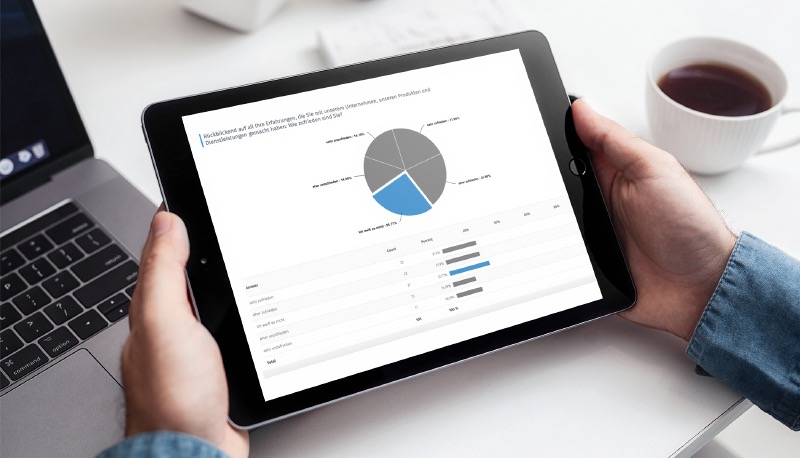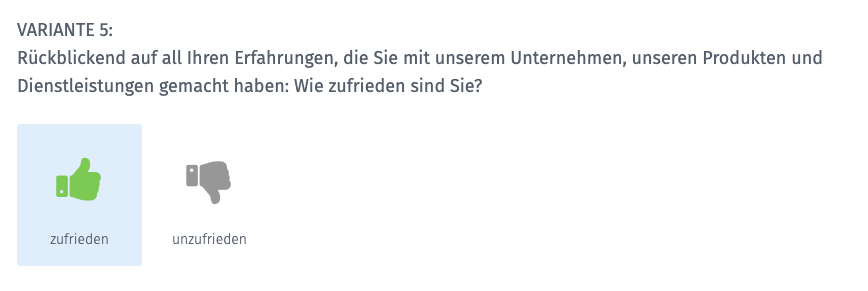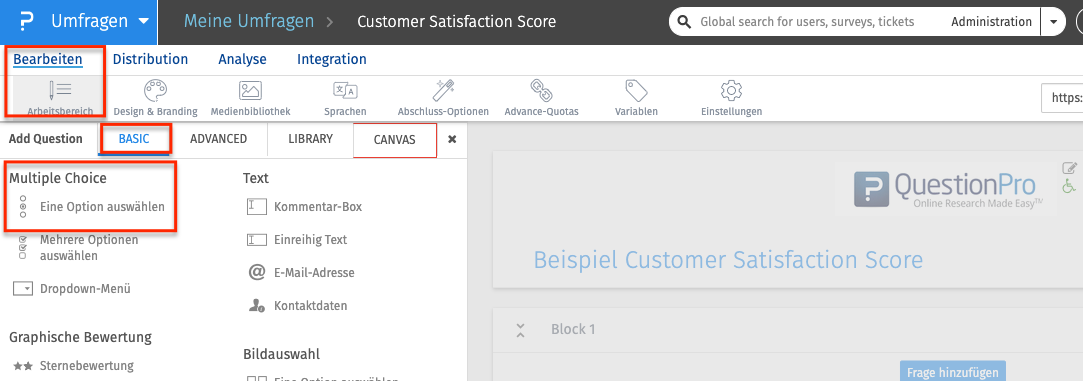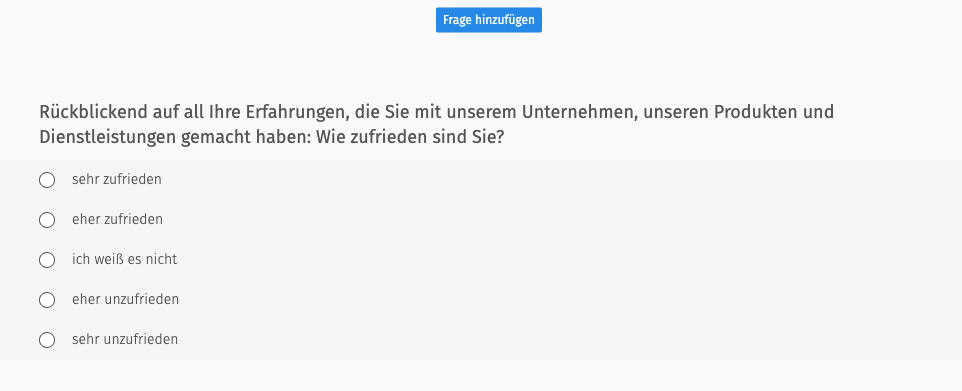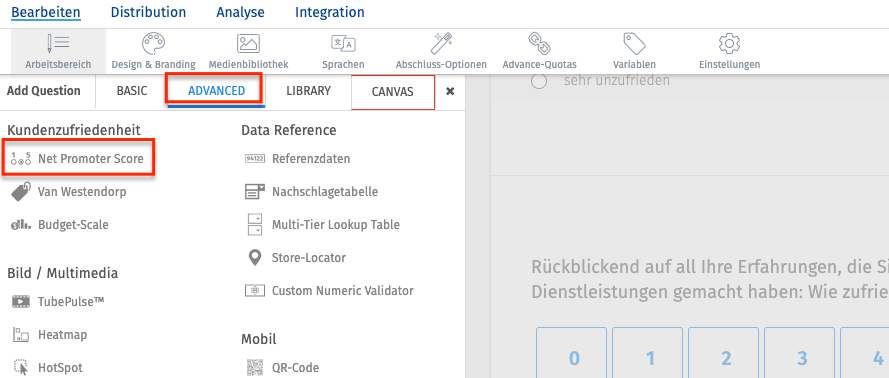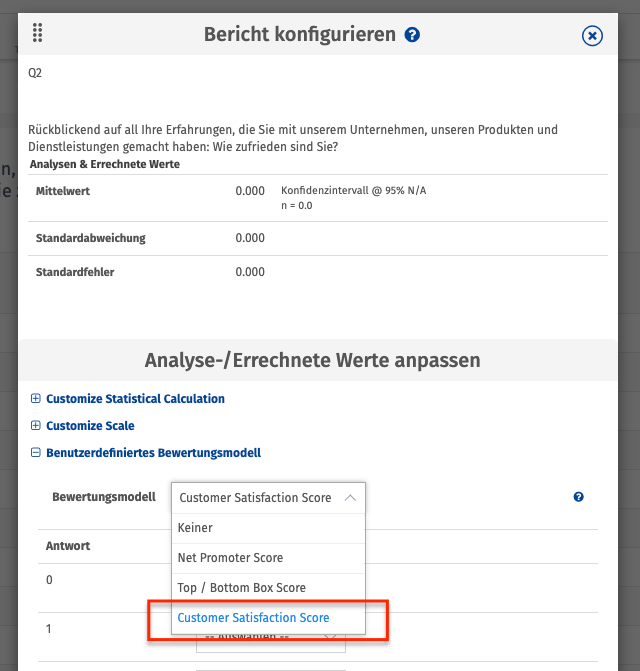Customer Experience Management
Mit dem Customer Satisfaction Score (CSAT) ermitteln Sie schnell und einfach den Grad der Kundenzufriedenheit. Nutzen Sie hierzu QuestionPro und die vordefinierte CSAT Frage
Customer Satisfaction Score ermitteln mit QuestionPro
- 1 Definition: Customer Satisfaction Score (CSAT)
- 2 CSAT-Berechnung: So ermitteln Sie den Customer Satisfaction Score
- 3 Was macht den Customer Satisfaction Score so wertvoll und wichtig?
- 4 Gründe und Vorteile zur Ermittlung der Kundenzufriedenheit mittels Customer Satisfaction Score
- 5 Customer Satisfaction Score ermitteln mit QuestionPro
- 6 Customer Satisfaction Score (CSAT) Beispiel
- 7 1:1 Live-Online-Demo: Customer Satisfaction Score (CSAT) ermitteln mit QuestionPro
- 8 Software zur Ermittlung des Customer Satisfaction Score (CSAT) jetzt 10 Tage kostenlos testen!
Definition: Customer Satisfaction Score (CSAT)
Was ist der Customer Satisfaction Score (CSAT)?
Der Customer Satisfaction Score (Abkürzung: CSAT) ist ähnlich wie auch der Customer Effort Score und der Net Promoter Score ein Key Performance Indikator (KPI), der den Grad der Zufriedenheit von Kunden eines Unternehmens angibt. Während sich die Kundenzufriedenheit mittels Customer Effort Score und Net Promoter Score nur indirekt ableiten lässt, ist das Ziel des Customer Satisfaction Score die direkte Messung und Darstellung der Kundenzufriedenheit.
Wie wird der Customer Satisfaction Score (CSAT) ermittelt?
Das Ermitteln der Kennzahl “CSAT” ist relativ einfach, da dieser im Grunde über eine einzige direkte Frage innerhalb einer Kundenbefragung oder Touchpoint Analyse erhoben wird.
“Wenn Sie einmal an Ihre Erfahrungen denken, die Sie mit unserem Unternehmen, unseren Produkten und Dienstleistungen gemacht haben: Wie zufrieden sind Sie insgesamt?”
In der Regel geben Unternehmen Ihren Kunden hierbei mehrere Antwortmöglichkeiten mittels einer Single-Choice-Frage vor, hier exemplarisch anhand einer fünfer Skala:
▢ sehr zufrieden
▢ zufrieden
▢ ich weiß es nicht / neutral
▢ unzufrieden
▢ sehr unzufrieden
Zur Umgehung der sogenannten “Mittelwertfalle”, also die Wahrscheinlichkeit, dass Kunden nicht selten dazu tendieren, die mittlere Antwortoption zu nutzen, verwenden einige Unternehmen auch 4 oder 6 Antwortmöglichkeiten zur Ermittlung des CSAT.
Im Grunde sind alle Varianten zielführend um den CSAT zu ermitteln. Man sollte jedoch bedenken, dass gerade bei “mobilen Befragungen”, also Kundenbefragungen oder Touchpoint Analysen, die höchstwahrscheinlich über das Smartphone beantwortet werden, der Fragebogen und entsprechend die Antwortmöglichkeiten so knapp und übersichtlich wie möglich gestaltet werden sollte, um eine möglichst hohe Zahl an CSAT-Feedback zu erhalten.
Zahlenwerte zur CSAT-Ermittlung
Eine weitere Variante zur Ermittlung eines CSAT-Scores ist die Möglichkeit der Nutzung einer 10er-Zahlenskala, ähnlich die des Net Promoter Scores, wobei 1 die schlechteste und 10 die beste Bewertung darstellt.
▢ 1 ▢ 2 ▢ 3 ▢ 4 ▢ 5 ▢ 6 ▢ 7 ▢ 8 ▢ 9 ▢ 10
Antwortoptionen über Symbole
Auch Symbole werden selbstverständlich zur Ermittlung des CSAT sehr gerne verwendet. Die bevorzugten Varianten sind etwa Sternchen oder Smileys.
Aber auch die Verwendung von 2 Antwortoptionen zur Ermittlung des Customer Satisfaction Score via Like/Dislike-Symbole sind uns schon begegnet. Dies kann dann etwa wie folgt aussehen:
CSAT-Berechnung: So ermitteln Sie den Customer Satisfaction Score
Es gibt unterschiedliche Berechnungsmodelle zur Ermittlung des CSAT, wobei sich folgende Berechnung etabliert hat:
Häufig wird der Customer Satisfaction Score (CSAT) noch mit einhundert multipliziert.
Beispiel der Berechnung des CSAT-Scores bei einer Frage mit 5 Ausprägungen.
Nehmen wir folgende Antwortverteilung an:
sehr zufrieden: 123
eher zufrieden: 77
neutral / keine Meinung: 82
eher unzufrieden: 62
sehr unzufrieden: 9
———————–
Befragte gesamt: 353
davon zufrieden: 200
200 x 100 / 353 = 56,7
Bedenken Sie, dass es für ein etwaiges Benchmarking notwendig ist, dass die veröffentlichten CSAT-Werte, mit denen Sie die CSAT-Werte Ihres Unternehmens vergleichen, auf der gleichen Berechnungsgrundlage ermittelt wurden.
Was macht den Customer Satisfaction Score so wertvoll und wichtig?
Wie bereits oben beschrieben ist die Frage zur Ermittlung des CSAT sehr pointiert. Ohne Umschweife werden Kunden damit konfrontiert und müssen ad hoc darauf reagieren, quasi aus einer “Top Of Mind” Situation heraus, was ungefiltertes und ehrliches Feedback garantiert. Und genau das macht den CSAT zu einem sehr wichtigen Indikator dafür, ob Ihre Mitarbeiter dafür Sorge tragen, dass die Kunden Ihres Unternehmens zufrieden sind und diese im Zentrum allen Denkens und Handelns stehen.
Gründe und Vorteile zur Ermittlung der Kundenzufriedenheit mittels Customer Satisfaction Score
Einfache Anwendung der CSAT-Frage
Der Customer Satisfaction Score ist sehr einfach durch eine einzige Frage zu ermitteln. Aufgrund dieser Einfachheit eignet sich die Verwendung der Frage zum CSAT hervorragend für Mikro-Befragungen im Rahmen von Touchpoint-Analysen. Sie müssen also nicht zig Fragen stellen, um herauszufinden, ob Ihre Kunden zufrieden sind.
Einfache Auswertung des CSAT-Score
So einfach die Anwendung des Customer Satisfaction Score innerhalb eines Fragebogens ist, so einfach ist auch die Auswertung, da es hier aufgrund der Klarheit der Fragestellung kaum bis keine Interpretationsspielräume gibt. Am Ende dieses Artikels finden Sie einen Link zu einem CSAT-Beispielfragebogen inklusive Auswertung. Die folgende CSAT-Beispielauswertung gibt Ihnen einen ersten Eindruck zur Einfachheit.
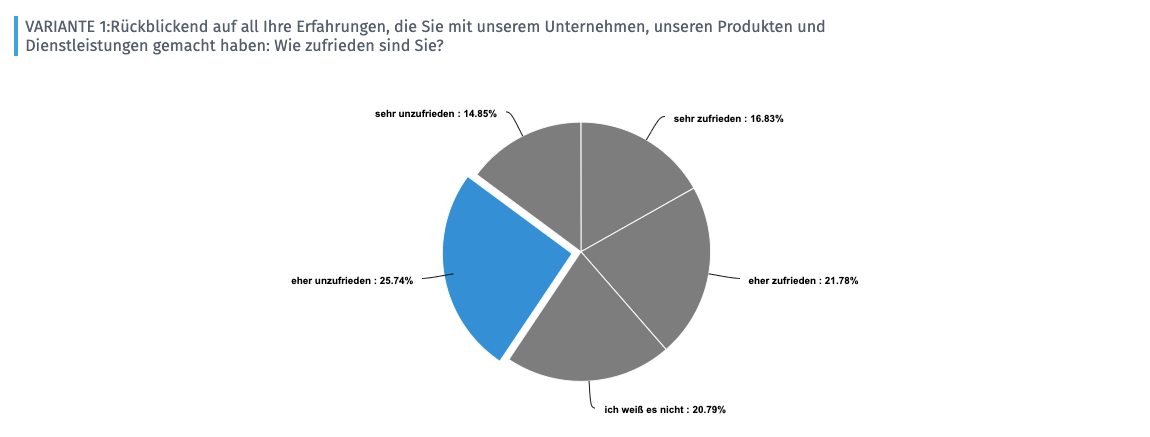
Interaktionsbasierter Customer Satisfaction Score
Wie oben beschrieben läßt sich der Customer Satisfaction Score wunderbar mittels Touchpoint Analysen ermitteln. Das bedeutet, dass Sie nach jeder Interaktion zwischen Ihren Kunden und Ihrem Unternehmen eine CSAT-Befragung initiieren können, etwa im Anschluss an eine Supportanfrage oder Beschwerde, nach einer telefonischen Anfrage, nach einer E-Mail-Anfrage, nach einem Bestellprozess oder auch nach dem Besuch eines Stores, etwa via Feedback Terminal. Durch die Zuordnung zu den jeweiligen Kontaktpunkten erhalten Sie also einen interaktionsbasierten Customer Satisfaction Score.
Der Customer Satisfaction Score bietet einen hohen Feedback-Rücklauf
Aufgrund der Einfachheit zur Ermittlung des Customer Satisfaction Score erhalten Sie sehr viel Feedback, da sich Ihre Kunden nicht an einem ellenlangen Fragebogen abarbeiten müssen. Erhalten Kunden etwa per E-Mail einen Fragebogen mit nur einer einzigen Frage, die womöglich bereits in den E-Mail-Body integriert ist, ohne dass hierbei ein Link zu einer Umfrage angeklickt werden muss, so ist die Bereitschaft der Beantwortung recht hoch.
Einfaches CSAT Benchmark
Im Netzt kursieren eine Menge CSAT-Benchmark-Veröffentlichungen, unterteilt nach Branchen und Bereichen, mit denen Sie Ihre eigenen Werte vergleichen können. Achten Sie bitte darauf, dass – wie bereits oben beschrieben – die Berechnungsgrundlagen des CSAT-Scores einheitlich sind.
Customer Satisfaction Score ermitteln mit QuestionPro
Wenn Ihnen QuestionPro bekannt ist, so wissen Sie vielleicht, dass die Erhebungs- und Analyse-Plattform aus unterschiedlichen Modulen besteht, nämlich aus je einem Modul für Umfragen und Marktforschung, für das Customer Experience Management und für das Employee Experience Management. Den CSAT- Score können Sie sowohl mit dem Umfrage- und Marktforschungs-Modul als auch mit der Customer Experience Management Variante in nur wenigen Schritten ermitteln.
CSAT ermitteln mit der Umfrage- und Marktforschungsplattform
QuestionPro bietet Ihnen sehr einfache Möglichkeiten zur Ermittlung des Customer Satisfaction Score. Öffnen Sie hierzu einfach den Fragebogen-Editor und währen Sie aus der Frage-Bibliothek den Fragetypen “Single-Choice” aus. Formulieren Sie anschließend Ihre Frage und fügen Sie wie gewünscht eine bestimmte Anzahl von Antwortoptionen hinzu.
Eine weitere Variante zur Ermittlung des Customer Satisfaction Score innerhalb der Umfrage- und Marktforschungs-Plattform ist die Verwendung des Net Promoter Score (NPS) Fragetypen. Hier können Sie eine unterschiedliche Anzahl von Antwortoptionen auf einer Zahlenskala definieren. Wählen Sie zunächst den Net Promoter Score Fragetypen aus, klicken Sie dann auf EINSTELLUNGEN und wählen Sie das gewünschte Antwortformat.
Anschließend wechseln Sie die Ansicht vom Fragebogen-Editor zum Menüpunkt ANALYSE. Hier wählen Sie das Einstellrad neben der Frage und wählen Sie als benutzerdefiniertes Bewertungsmodell “Customer Satisfaction Score”.
CSAT ermitteln mit der Customer Experience Management Plattform
Die Customer Experience Management Plattform von QuestionPro ist das Modul zur Erstellung von Touchpoint Analysen, mit denen Sie Customer Touchpoints innerhalb der Customer Journey nachhaltig tracken und somit optimieren können. Die Erstellung eines Fragebogens zur Ermittlung des Customer Satisfaction Score verhält sich hier sehr ähnlich wie im oben beschriebenen Beispiel, wobei es hier jedoch ein bereits vordefiniertes Frage-Set gibt.
Customer Satisfaction Score (CSAT) Beispiel
Wir haben für Sie zur Veranschaulichung der Einfachheit das Beispiel eines Fragebogens zum CSAT mit QuestionPro erstellt. Am Ende des Fragebogens gelangen Sie zur Auswertung. Und hier finden Sie den Beispiel-Fragebogen zum Customer Satisfaction Score
1:1 Live-Online-Demo:
Customer Satisfaction Score (CSAT) ermitteln mit QuestionPro
Sehr gerne zeigen wir Ihnen im Rahmen einer 1:1 Live-Online-Präsentation, wie Sie mit der CX-Software von QuestionPro den Customer Satisfaction Score CSAT schnell und einfach ermitteln und automatisch eine CSAT-Auswertung generieren können.
Vereinbaren Sie einen individuellen Termin
Software zur Ermittlung des Customer Satisfaction Score (CSAT) jetzt 10 Tage kostenlos testen!
Sie haben Fragen zum Customer Satisfaction Score? Kontaktieren Sie uns ganz einfach über das Kontaktformular. Wir freuen uns auf den Dialog mit Ihnen! Sehr gerne schalten wir Ihnen auch einen 14-Tage-Test der Plattform für Marktforschung und Experience Management frei.
Testen Sie jetzt 10 Tage kostenfrei die agile Marktforschungs- und Experience Management Plattform für qualitative und quantitative Datenerhebung und Datenanalyse von QuestionPro
WEITERFÜHRENDE STICHWORTE
DIESEN ARTIKEL TEILEN
STICHWÖRTER DIESES BLOG-BEITRAGS
CSAT | Customer Satisfaction Score | Kundenzufriedenheit | Wichtigkeit
WEITERFÜHRENDE INFOS IM KONTEXT CSAT
- Quantitative und qualitative Marktforschung durchführen mit QuestionPro (Qual & Quant)
- Net Promoter Score (NPS) ermitteln mit QuestionPro: Definition, Berechnung, Feedback, Auswertung, Beispiel
- Customer Effort Score (CES):
Definition, Ziel, Beispiel-Fragebogen, Vorlage, Live-Online-Präsentation - Der große QuestionPro-Guide zum Thema Kundenbefragung: Definition, Entwicklung, Methoden, Beispiele, Auswertung, Vorlage für den Import.
- Customer Experience Management: Beispiele, Erläuterungen, Tipps, Best Practices
- Software und Service für agile Marktforschung. Übersicht und 1:1 Live-Online-Präsentation mit Wunschtermin!

